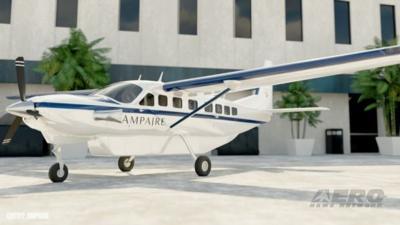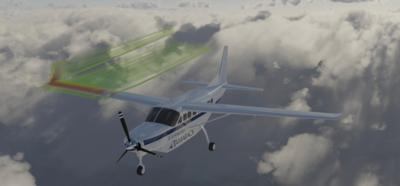Successful Maiden Flight Bodes Well for Hybrid-Electric Aircraft Architectures
Founded in 2016 under the guiding principle of establishing itself as the world’s foremost developer of practical electric aircraft, Los Angeles-based Ampaire has made headlines and demonstrable progress toward upgrading existing utility aircraft to hybrid-electric power.

On Friday, 18 November 2022, Ampaire’s Eco Caravan made its maiden flight from Camarillo Airport (CMA)—thereby heralding the actualization of the company’s ambitious objectives.
Piloted by Elliot Seguin, the nine-passenger Eco Caravan flew for 33-minutes, during which Seguin climbed the aircraft to 3,500 feet at full-output of the hybrid internal-combustion-electric powertrain. At cruise, Seguin devoted approximately twenty-minutes to conducting various power tests and collecting powerplant performance data.
In a post-flight statement, Seguin asserted: “The Eco Caravan propulsion system performed just as expected. It was smooth and quiet. All temperature and power output readings were normal.”
The Eco Caravan is the first hybrid-electric aircraft to enter into the FAA’s formal certification process. Ampaire expects the agency to bestow supplemental type certification—tailored for the newly ascended machine’s hybrid propulsion system—upon the Eco Caravan in 2024. Ampaire’s brass maintains an STC scheme will prove less costly and time-consuming than a full aircraft certification program.
In essence, the Eco Caravan is a hybrid-electric-powered iteration of Cessna’s 208B Grand Caravan. Ampaire asserts the model will afford operators up to seventy-percent reductions in both fuel consumption and engine-emissions over the legacy turboprop Caravan while preserving payload capability and extending range. Ampaire further asserts its Eco Caravan is effectively carbon neutral when operated on sustainable aviation fuel, and that the machine’s operating costs are 25 to 40-percent lower than those of the standard Grand Caravan.
The electric facet of the Eco Caravan’s hybrid propulsion architecture is powered by EP Systems’ EPiC battery pack, the cell technology of which provides an energy density of over 200Wh/kg (Watt-hours per kilogram) at the battery pack level. Under typical usage, the EPiC system is capable of undergoing two-thousand fast-charge cycles between replacements. The complementary internal combustion aspect of the Eco Caravan’s powerplant comprises RED Aircraft’s A03 series engine—a four-stroke, five-hundred-horsepower, V-12, diesel aircraft engine produced by RED Aircraft GmbH of Adenau, Germany.

As Ampaire’s hybrid-electric drive charges in flight, the Eco Caravan requires no ground-charging infrastructure and can operate, ostensibly, across the selfsame remote, backcountry environs to which the legacy Grand Caravan is so eminently suited.
In a post-flight statement of his own, Ampaire CEO Kevin Noertker remarked: “Aviation is the hardest industry to decarbonize. Fully-electric aircraft are range-limited because of the weight and energy capacity of current-generation batteries. Hybrid-electric aircraft, however, can preserve the range and utility of today’s aircraft. That is why we are focused on hybrid-electric propulsion for a series of increasingly capable regional aircraft.”
During October’s NBAA-BACE 2022, Ampaire signed a Memorandum of Understanding (MOU) with Tamarack Aerospace Group by which Ampaire’s alternative energy variants of Cessna’s 208 Caravan, de Havilland’s Twin Otter, and Beechcraft’s King Air will be retrofitted with Tamarack’s SMARTWING technology.
Mr. Noertker added: “Launching hybrid-electric aviation is no simple task, but we have made it easier by upgrading an already certified aircraft. We will come to market more quickly and allow airlines around the world to begin to gain operational experience with this new type of propulsion, and we will work with them on follow-on models to meet their network requirements.”
 ANN's Daily Aero-Linx (05.02.24)
ANN's Daily Aero-Linx (05.02.24) ANN's Daily Aero-Term (05.02.24): Touchdown Zone Lighting
ANN's Daily Aero-Term (05.02.24): Touchdown Zone Lighting Aero-News: Quote of the Day (05.02.24)
Aero-News: Quote of the Day (05.02.24) ANN FAQ: Contributing To Aero-TV
ANN FAQ: Contributing To Aero-TV NTSB Final Report: Cirrus Design Corp SR20
NTSB Final Report: Cirrus Design Corp SR20




